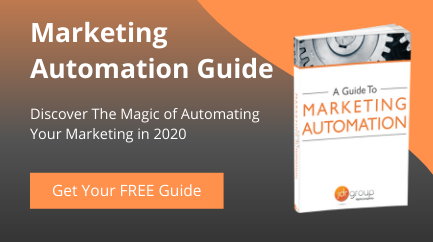The 1 Thing You Must Never Do With Marketing Automation Tools
by Will Williamson on 04-Aug-2016 11:34:00
 Marketing Automation tools are extremely easy to use. Most platforms have a very intuitive UI, can be implemented with a minimum of training, and if used correctly can bring amazing results in a short period of time. So the purpose of this article isn’t to scare you into not using Marketing Automation. Pressing the wrong button won’t blow up your office, or alienate your customers, or wipe millions off of your balance sheet. You can relax.
Marketing Automation tools are extremely easy to use. Most platforms have a very intuitive UI, can be implemented with a minimum of training, and if used correctly can bring amazing results in a short period of time. So the purpose of this article isn’t to scare you into not using Marketing Automation. Pressing the wrong button won’t blow up your office, or alienate your customers, or wipe millions off of your balance sheet. You can relax.
However, Marketing Automation should be approached as an investment. All the premium platforms come with a monthly subscription cost (usually billed annually), and many have set up fees of £2,000 or more, so you should think it through and probably talk to a marketing expert before you sign up to something.
A few lesser mistakes…
It is possible to make a bad investment decision with Marketing Automation, not because the concept doesn’t work, or even that your money is better spent elsewhere, but because of problems with the planning process.
For instance, some businesses make the mistake of choosing a Marketing Automation platform that doesn’t suit their needs; in other words, one that doesn’t have all the functions they need to fulfil their marketing goals. Or they might pick a platform that doesn’t sit well with their budget, so they struggle to make a sufficient return on their investment. Or the new Marketing Automation platform may not integrate well with their other apps, meaning it becomes more of a hindrance than a help.
As problematic as these issues are, they can all be avoided with forward planning, and most can be remedied even after the event. They are as child’s play compared with the ONE mistake companies should avoid at all costs with marketing automation – one that is sadly all too common:
The BIG Mistake
The one thing you must never do with a marketing automation platform is to make your investment, set up your system and get ready for action without any real clue about how to use it properly.
Underpinning the successful use of a Marketing Automation platform is an Automation Strategy i.e. a clear vision for how the application is going to be used, the goals you expect to reach and how the results will be analysed. This sits within an overall Marketing Strategy for your business.
This strategy won’t come out of thin air, nor is it written into the platform, which after all, is simply a tool. You need to do some ground work before purchase and immediately after implementation in order for your new Marketing Automation tool to be of any real use. Not doing so is the equivalent to buying a top of the range, all-terrain vehicle without having a driving licence; or booking a swanky, five-star hotel break in New York without arranging your flights.
Fortunately, there are some easy ways to avoid this cardinal error and to make sure your Marketing Automation Platform works well for you from day one:
1) Have a marketing strategy!
Marketing Automation - and your automation strategy – works as part of an overall Marketing Strategy, not as a substitute for one. So the first thing to do before you choose a package is to determine your business goals, what sort of ROI you are looking for and what features you may need from a Marketing Automation platform.
You should set a realistic budget at this stage, based on what your business can afford. If you have a marketing strategy but the details are not yet ironed out, this is the time to do so. Look at all the details and get a comprehensive strategy in place. It may be worth your while talking to a consultant at this stage if you don’t have the relevant skills in-house. It will save you money and time further down the line if you do this before you make any purchase decisions.
2) Know who your users are going to be
Most Marketing Automation applications allow you to add more than one user. The more users you need to add, the higher your subscription cost may be, so have a clear idea about who is going to be using the platform before you implement it. This will simplify your training task during the onboarding process and will ensure that all the relevant people in your organisation have access to the platform from the beginning.
3) Use your Onboarding Period
Once you have your strategy and internal infrastructure in place, you are ready to start implementing marketing automation. Use your onboarding process to the full to gain a thorough familiarity with your platform. However, as well as building an understanding of the features of your platform, you should also use this time to experiment with some workflows before launching yourself into your full automation strategy.
These standard automation workflows will include using features such as opt-in forms, lead scoring and buyer personas. Creating these workflows will give your team an immediate appreciation for how your new platform can be used to gain results for your business, and not simply how it works in general.
Going Solo or With a Partner?
If you want to use marketing automation, there is nothing stopping you doing the research, signing up online and then using the platform’s training resources to get you started. However, when doing so, many businesses run into the problems we have mentioned in this article. Marketing Automation applications are technical tools with a lot of features. It is easy to overlook some of them. Furthermore, it is tempting to dive into marketing automation without having your house in order first. The results from taking this approach can be erratic and disappointing.
The alternative is to sign up for a Marketing Automation tool through a partner, such as JDR. The benefits of this approach come from the partner’s expertise in Marketing Automation, and their ability to help you lay solid foundations on which to build success. To find out more about how Marketing Automation tools can work for your business, please get in touch with one of our team today.
- Inbound Marketing (SEO, PPC, Social Media, Video) (819)
- Strategy (360)
- Sales & CRM (191)
- Marketing Automation & Email Marketing (190)
- Business Growth (161)
- Website Design (160)
- Hubspot (136)
- Lead Generation (113)
- Google Adwords (98)
- Content Marketing (94)
- Case Studies (47)
- News (47)
- Conversion (44)
- Ecommerce (38)
- Webinars (33)
- SEO (24)
- AI (19)
- Events (19)
- Video (17)
- LinkedIn Advertising (15)
- Video Selling (15)
- Software training (13)
- Niche business marketing (11)
- The Digital Prosperity Podcast (10)
- Facebook Advertising (6)
- HubSpot Case Studies (5)
- November 2025 (6)
- October 2025 (17)
- September 2025 (16)
- August 2025 (14)
- July 2025 (14)
- June 2025 (5)
- May 2025 (19)
- April 2025 (15)
- March 2025 (13)
- February 2025 (13)
- January 2025 (8)
- December 2024 (2)
- November 2024 (4)
- October 2024 (21)
- September 2024 (4)
- August 2024 (8)
- July 2024 (14)
- June 2024 (16)
- May 2024 (25)
- April 2024 (15)
- March 2024 (18)
- February 2024 (5)
- January 2024 (10)
- December 2023 (6)
- November 2023 (10)
- October 2023 (13)
- September 2023 (12)
- August 2023 (14)
- July 2023 (13)
- June 2023 (14)
- May 2023 (15)
- April 2023 (13)
- March 2023 (14)
- February 2023 (13)
- January 2023 (15)
- December 2022 (13)
- November 2022 (6)
- October 2022 (8)
- September 2022 (22)
- August 2022 (15)
- July 2022 (13)
- June 2022 (16)
- May 2022 (14)
- April 2022 (16)
- March 2022 (17)
- February 2022 (11)
- January 2022 (8)
- December 2021 (6)
- November 2021 (7)
- October 2021 (11)
- September 2021 (10)
- August 2021 (7)
- July 2021 (7)
- June 2021 (4)
- May 2021 (4)
- April 2021 (1)
- March 2021 (3)
- February 2021 (5)
- January 2021 (4)
- December 2020 (7)
- November 2020 (6)
- October 2020 (5)
- September 2020 (9)
- August 2020 (18)
- July 2020 (17)
- June 2020 (17)
- May 2020 (10)
- April 2020 (21)
- March 2020 (24)
- February 2020 (21)
- January 2020 (12)
- December 2019 (23)
- November 2019 (12)
- October 2019 (14)
- September 2019 (16)
- August 2019 (15)
- July 2019 (13)
- June 2019 (6)
- May 2019 (8)
- April 2019 (4)
- March 2019 (2)
- February 2019 (2)
- January 2019 (2)
- December 2018 (3)
- November 2018 (24)
- September 2018 (11)
- August 2018 (9)
- June 2018 (3)
- May 2018 (6)
- April 2018 (14)
- March 2018 (12)
- February 2018 (16)
- January 2018 (15)
- December 2017 (15)
- November 2017 (18)
- October 2017 (23)
- September 2017 (19)
- August 2017 (28)
- July 2017 (27)
- June 2017 (25)
- May 2017 (18)
- April 2017 (17)
- March 2017 (16)
- February 2017 (17)
- January 2017 (14)
- December 2016 (21)
- November 2016 (27)
- October 2016 (25)
- September 2016 (16)
- August 2016 (20)
- July 2016 (19)
- June 2016 (14)
- May 2016 (20)
- April 2016 (24)
- March 2016 (22)
- February 2016 (28)
- January 2016 (27)
- December 2015 (28)
- November 2015 (19)
- October 2015 (9)
- September 2015 (12)
- August 2015 (5)
- July 2015 (1)
- June 2015 (10)
- May 2015 (3)
- April 2015 (11)
- March 2015 (14)
- February 2015 (15)
- January 2015 (12)
- December 2014 (2)
- November 2014 (23)
- October 2014 (2)
- September 2014 (2)
- August 2014 (2)
- July 2014 (2)
- June 2014 (7)
- May 2014 (14)
- April 2014 (14)
- March 2014 (7)
- February 2014 (2)
- January 2014 (7)
- December 2013 (9)
- November 2013 (14)
- October 2013 (17)
- September 2013 (3)
- August 2013 (6)
- July 2013 (8)
- June 2013 (4)
- May 2013 (3)
- April 2013 (6)
- March 2013 (6)
- February 2013 (7)
- January 2013 (5)
- December 2012 (3)
- November 2012 (2)
- September 2012 (1)
Subscribe by email
You May Also Like
These Related Blogs

Marketing Strategies for a Thriving UK Industrial Sector
After several difficult years for the UK industrial sector, there are strong signs that the sector is starting to grow again. Q3 2023 was the first ti …

The Importance Of Professional Marketing Expertise In Your Manufacturing Business
Manufacturing businesses make two critical errors with marketing: they either follow the same generic marketing formula used by other industries, or t …

How Can Businesses Within The Arts & Entertainment Industry Grow Using Inbound Marketing?
Inbound marketing can sometimes come across as being useful only to knowledge-based, industrial, B2B businesses but that is not the case. There are to …



